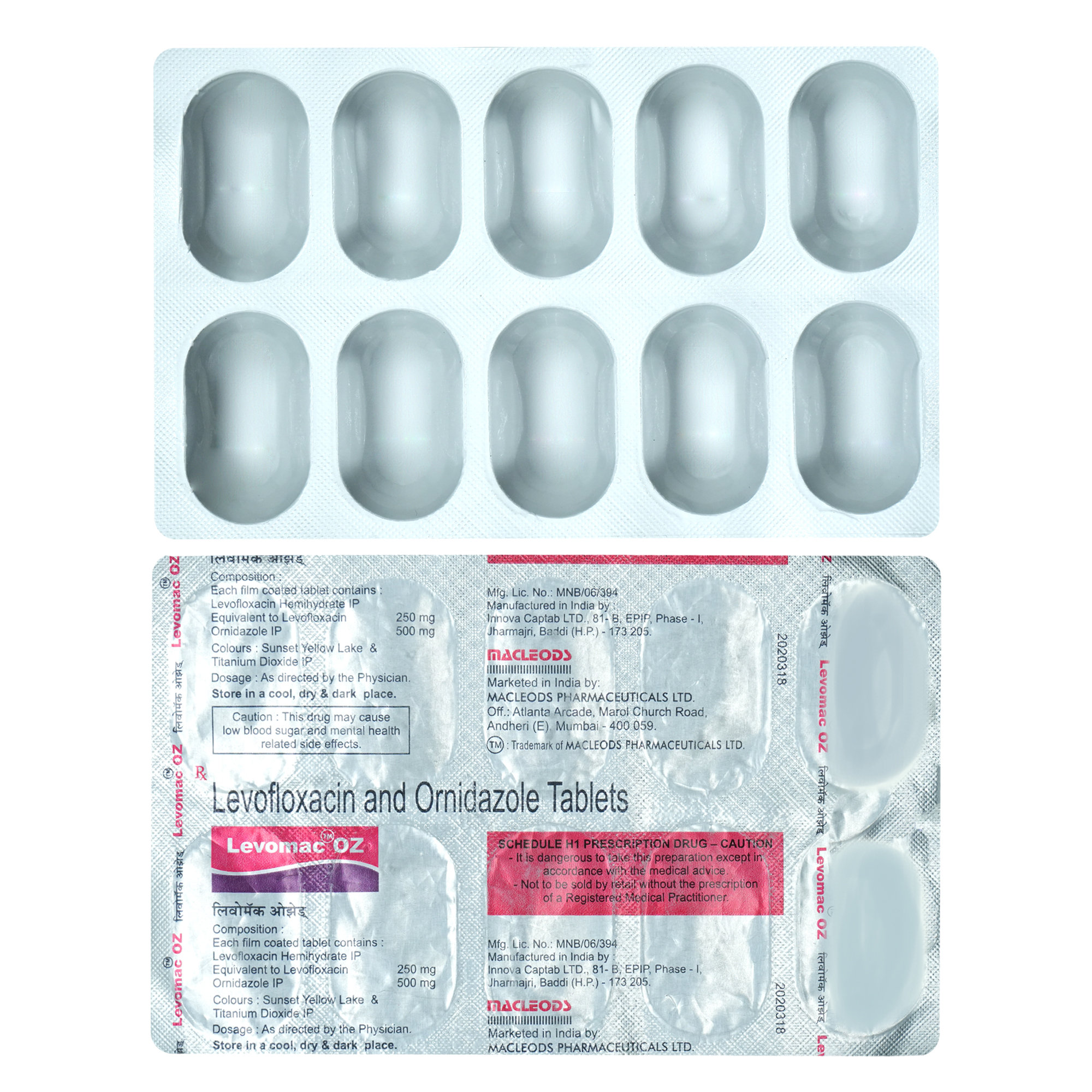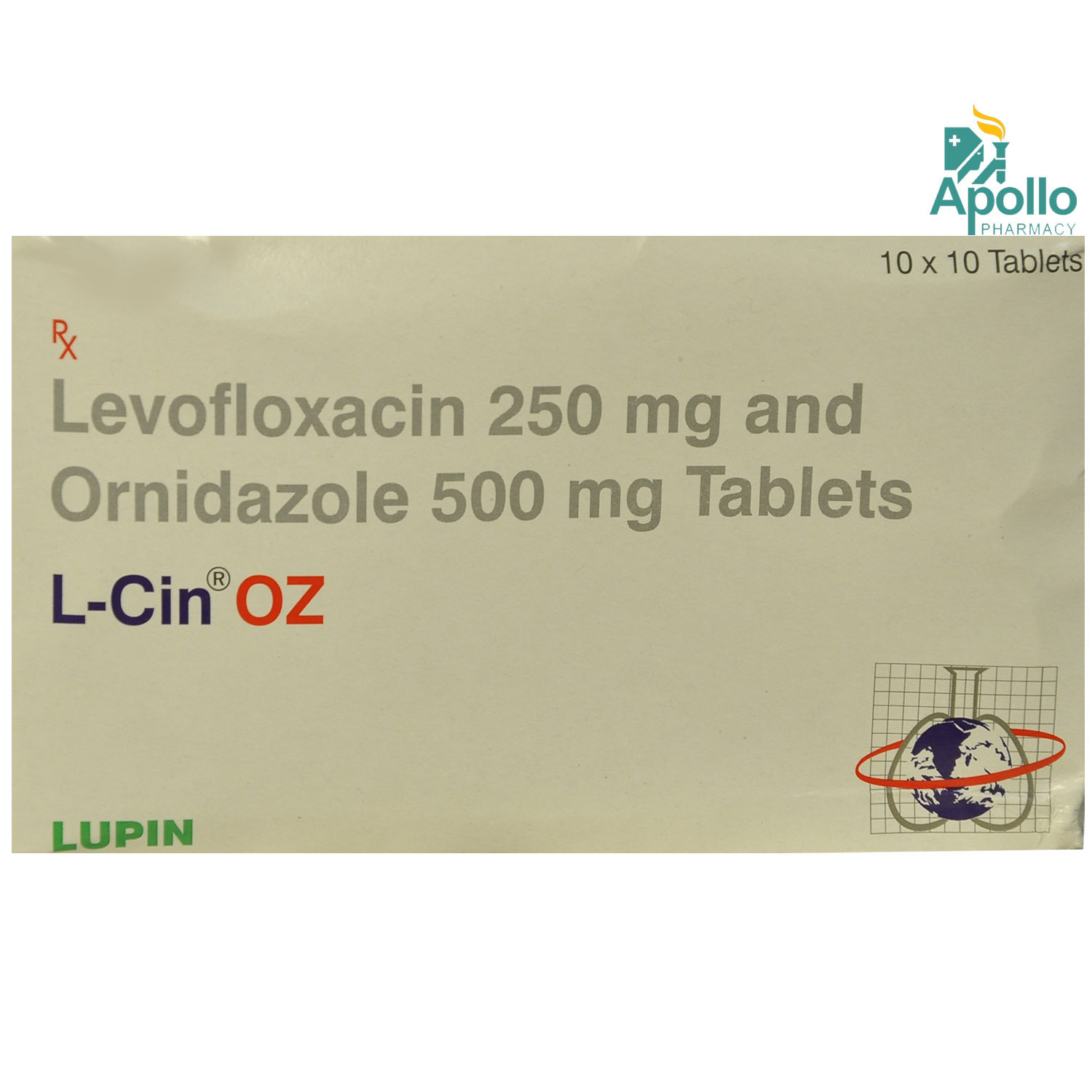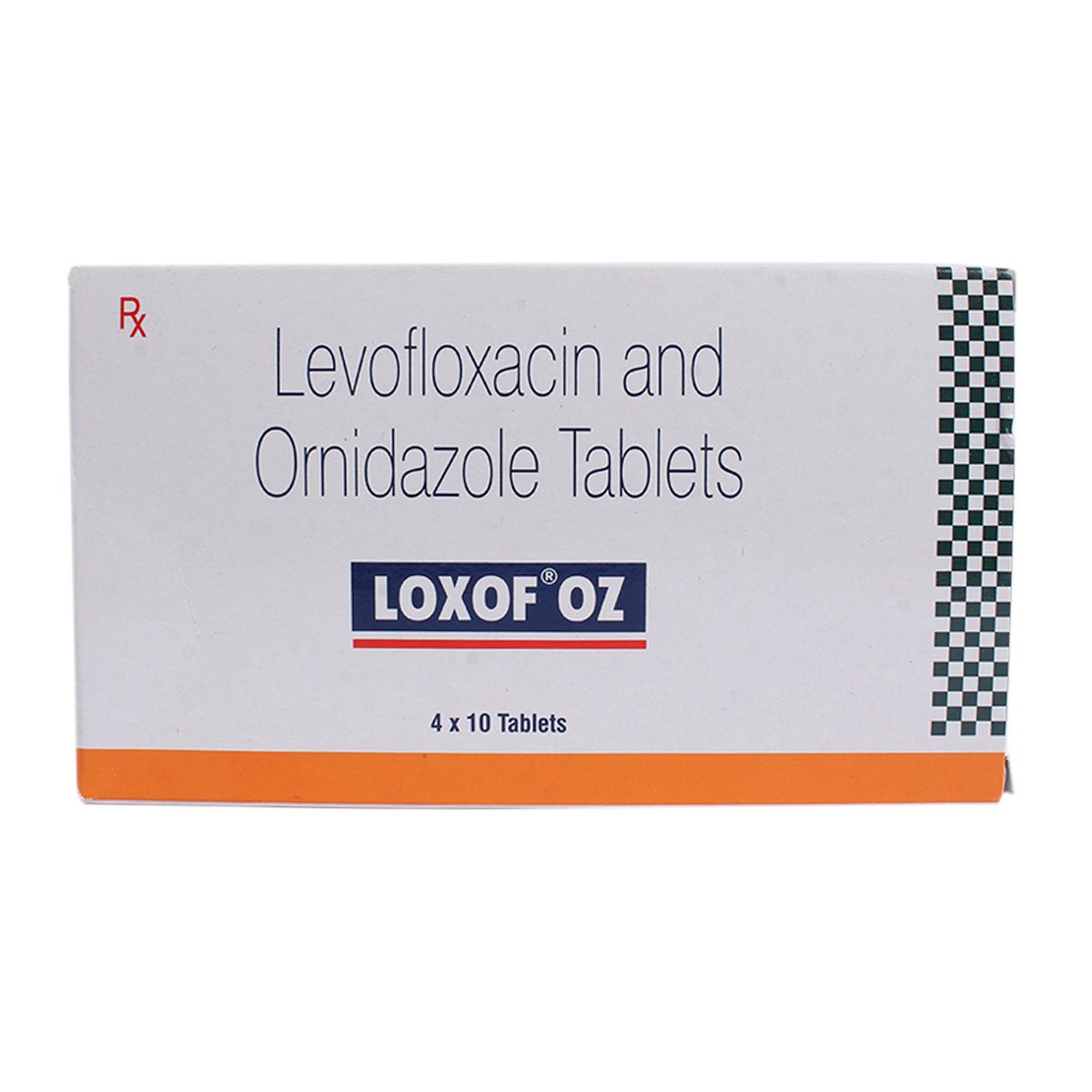QURE OZ TABLET

MRP ₹125.5
(Inclusive of all Taxes)
₹15.1 Cashback (12%)
know your delivery time
Provide Delivery Location
Composition :
Manufacturer/Marketer :
Consume Type :
Expires on or after :
Return Policy :

Secure Payment

Trusted by 8 Crore Indians

Genuine Products
Therapeutic Class
Country of origin
Manufacturer/Marketer address
Author Details
We provide you with authentic, trustworthy and relevant information
Disclaimer
Alcohol
Safe if prescribed
Alcohol consumption may worsen the side effect of QURE OZ TABLET like dizziness. It is better to avoid alcohol while you are being treated with QURE OZ TABLET.
Pregnancy
Consult your doctor
QURE OZ TABLET is not recommended for use during pregnancy since it may have harmful effects on the developing baby. Please consult your doctor if you are planning to become pregnant or already pregnant before starting QURE OZ TABLET.
Breast Feeding
Consult your doctor
Levofloxacin in QURE OZ TABLET is excreted into the breast milk. Please consult your doctor before taking QURE OZ TABLET if you are breastfeeding.
Driving
Safe if prescribed
QURE OZ TABLET may make you feel dizzy. Do not drive or operate machinery if you experience any impairment of skills, dizziness, and visual disturbances while using QURE OZ TABLET.
Liver
Consult your doctor
Please take QURE OZ TABLET with caution and doctor's advice if you have a history of liver diseases/conditions.
Kidney
Consult your doctor
Please take QURE OZ TABLET with caution and doctor's advice if you have a history of kidney diseases/conditions.
Children
Safe if prescribed
QURE OZ TABLET is not recommended for patients younger than 18 years of age.
Product Substitutes
About QURE OZ TABLET
QURE OZ TABLET belongs to the class of 'antibiotics', primarily used to treat diarrhoea and dysentery. It helps treat various bacterial and parasitic infections, such as pneumonia, bronchitis, intestinal, vaginal, urinary tract infections and genital infections. Diarrhoea is a condition that causes the frequent passing of loose or watery stools. Dysentery is an intestinal inflammation that leads to severe diarrhoea accompanied by mucus or blood in the stools. Bacterial infections are caused due to the multiplication of harmful bacteria inside or on the body.
QURE OZ TABLET contains two antibiotic medicines, namely: Levofloxacin and Ornidazole. Levofloxacin belongs to a class of drugs called quinolone antibiotics. It works by inhibiting an enzyme called gyrase, which is responsible for the growth and development of bacterial DNA. Ornidazole is an anti-amoebic/ amebicide (kills amoeba that causes amoebic dysentery) and antiprotozoal (fights against protozoal infections) medicine. It also exerts antibacterial action and kills harmful bacteria and parasites (amoeba) by damaging their DNA by interfering with the protein formation process.
Please take QURE OZ TABLET in the dose and duration prescribed by your doctor based on your medical condition. QURE OZ TABLET is generally safe to use. However, some may experience side effects like nausea, loss of appetite, constipation, diarrhoea, trouble sleeping, dizziness and headache. Most of these side effects of QURE OZ TABLET do not require medical attention and gradually resolve over time. If these side effects persist longer, please consult your doctor.
If you are allergic to QURE OZ TABLET or any other medicines, please tell your doctor. Do not suddenly stop this medicine to avoid unpleasant side effects and sudden withdrawal symptoms. Intake of probiotics, prebiotics and plenty of fluids is recommended if you suffer from dysentery and diarrhoea. Do not drive or operate heavy machinery after taking QURE OZ TABLET as it may cause dizziness. Avoid alcoholic beverages during your treatment, as it can worsen the disease and side effects. Pregnant and breastfeeding women should use QURE OZ TABLET with proper consultation and caution.
Uses of QURE OZ TABLET
Medicinal Benefits Mweb
Key Benefits
QURE OZ TABLET contains Levofloxacin and Ornidazole. It treats infections of bacteria and parasites. Levofloxacin is a quinolone antibiotic that inhibits bacterial DNA gyrase, an enzyme required for the replication, transcription and repair of the DNA. It is also used to treat anthrax (a rare but serious bacterial illness) and certain types of plague. Ornidazole is an anti-amoebic, antiprotozoal and antibacterial medicine. It kills harmful protozoa and certain anaerobic bacteria by damaging their DNA and interfering with the protein formation process. It treats amoebiasis (amoebic dysentery), giardiasis (infection of the small intestine) and trichomoniasis (a sexually transmitted infection caused by a parasite). Collectively, QURE OZ TABLET treats various bacterial and parasitic infections, such as diarrhoea, dysentery, pneumonia, bronchitis, intestinal, vaginal, urinary tract infections and genital infections. QURE OZ TABLET does not work for viral infections like common cold and flu.
Directions for Use
Side Effects of QURE OZ TABLET
- Nausea
- Loss of appetite
- Constipation
- Diarrhoea
- Trouble sleeping
- Dizziness
- Headache
Drug Warnings
Brief your medical history to doctor, if you are allergic to QURE OZ TABLET or any of its components. Please let your doctor know before starting QURE OZ TABLET if you have a history liver or kidney diseases, tendonitis (inflammation of the tendon, a tissue connecting muscle and bone), fits, diabetes, dehydration, blood dyscrasia (decreased peripheral blood cell counts), colitis (inflammation of the colon) or undergoing dialysis treatment. Levofloxacin in QURE OZ TABLET can make myasthenia gravis (muscle weakness) worse, hence you should take QURE OZ TABLET only under doctor's supervision. Please consult your doctor if you are pregnant or breastfeeding before starting QURE OZ TABLET. Do not drive or operate heavy machinery after taking QURE OZ TABLET as it may cause dizziness. Please try avoiding alcoholic beverages during your treatment, as it worsens the disease and side effects. QURE OZ TABLET is not recommended for patients younger than 18 years of age.
Drug-Drug Interactions
Drug-Drug Interactions
Login/Sign Up
The combination of Amiodarone and Qure Oz Tablet may significantly raise the risk of an abnormal heart rhythm.
How to manage the interaction:
Despite the fact that Amiodarone and Qure Oz Tablet interact, it can be taken if prescribed by a doctor. If you get dizziness, lightheadedness, fainting, or fast or racing heartbeats, consult a doctor. Do not stop taking any medications without visiting a doctor.
Taking Qure Oz Tablet with Ziprasidone can increase the risk of abnormal heart rhythm.
How to manage the interaction:
Taking Qure Oz Tablet with Ziprasidone is not recommended, but it can be taken together if prescribed by a doctor. However, consult your doctor if you experience sudden dizziness, lightheadedness, fainting, shortness of breath. Do not discontinue any medications without consulting a doctor.
Combining Qure Oz Tablet with Disopyramide can increase the risk of irregular heart rhythm .
How to manage the interaction:
Taking Qure Oz Tablet with Disopyramide is not recommended, as it can result in an interaction, it can be taken if your doctor has advised it. However, if you experience any symptoms like sudden dizziness, lightheadedness, fainting, or fast or pounding heartbeats, contact your doctor immediately. Do not discontinue any medications without first consulting your doctor.
Using sotalol together with Qure Oz Tablet can increase the risk of an irregular heart rhythm that may be serious. The risk increases in patients with a history of heart illness or electrolyte imbalance.
How to manage the interaction:
Taking Qure Oz Tablet with Sotalol is generally avoided as it can result in an interaction, it can be taken if your doctor has advised it. If you experience sudden dizziness, lightheadedness, fainting, or fast or pounding heartbeats, contact a doctor immediately. Do not discontinue any medications without consulting a doctor.
Coadministration of Qure Oz Tablet with Haloperidol can increase the risk or severity of irregular heart rhythms. The risk increases in patients with a history of heart illness or electrolyte imbalance.
How to manage the interaction:
Taking Qure Oz Tablet with haloperidol can result in an interaction, but it can be taken if a doctor has advised it. However, if you experience abrupt dizziness, lightheadedness, fainting, shortness of breath, or rapid heartbeat, get medical help immediately. Do not discontinue any medications without consulting a doctor.
Although it is a very rare adverse effect, taking Qure Oz Tablet with vemurafenib increases the risk of an abnormal heart rhythm. If you're dealing with other heart illnesses, electrolyte imbalances (for example, magnesium or potassium loss likely due to serious or prolonged diarrhea or vomiting), you may be at greater risk.
How to manage the interaction:
Although concomitant administration of Qure Oz Tablet with vemurafenib can possibly result in an interaction, it can be taken if your doctor has advised it. However, if you experience abrupt dizziness, lightheadedness, fainting, shortness of breath, or rapid heartbeat, get medical help immediately. Do not discontinue any medications without consulting a doctor.
Taking Qure Oz Tablet with anagrelide increases the risk of an abnormal heart rhythm.
How to manage the interaction:
Concomitant administration of Qure Oz Tablet alongside anagrelide can result in an interaction, it can be taken if a doctor has advised it. However, if you experience abrupt dizziness, lightheadedness, fainting, shortness of breath, or rapid heartbeat, get medical help immediately. Do not discontinue any medications without consulting a doctor.
Coadministration of Qure Oz Tablet and Leflunomide can increase the risk of liver issues.
How to manage the interaction:
Although concomitant administration of Qure Oz Tablet alongside leflunomide can result in an interaction, it can be taken if a doctor has advised it. However, if you have a fever, chills, joint pain or swelling, unusual bleeding or bruising, skin rash, itching, loss of appetite, fatigue, nausea, vomiting, abdominal pain, dark-colored urine, light-colored stools, and/or yellowing of the skin or eyes, contact the doctor right away. Do not discontinue any medications without consulting a doctor.
Coadministration of Qure Oz Tablet and Pasireotide can increase the risk of an irregular heart rhythm.
How to manage the interaction:
Taking Qure Oz Tablet with Pasireotide together can result in an interaction, but it can be taken if a doctor has advised it. If you have any symptoms like an irregular heartbeat, dizziness, fainting, or trouble breathing, you should call a doctor right away. Do not stop using any medications without talking to a doctor.
Using dofetilide together with Qure Oz Tablet can increase the risk of an irregular heart rhythm.
How to manage the interaction:
Although there is a possible interaction between Qure Oz Tablet and Dofetilide, you can take these medicines together if prescribed by a doctor. If you experience symptoms like an irregular heart rhythm, dizziness, fainting, or shortness of breath, it's important to call a doctor right away. Do not stop using any medications without a doctor's advice.
Drug-Food Interactions
Drug-Food Interactions
Login/Sign Up
Drug-Diseases Interactions
Drug-Diseases Interactions
Login/Sign Up
Drug-Drug Interactions Checker List
- WARFARIN
- ASPIRIN
- ESCITALOPRAM
- VECURONIUM
- QUINIDINE
- ETHINYLESTRADIOL
Habit Forming
Special Advise
- Levofloxacin can cause serious tendon problems and nerve damage, hence you should be cautious. If you experience any symptoms like severe headaches, extreme hunger, irritability, numbness, tingling, burning pain, confusion, agitation and memory problems, please stop using this medicine and seek immediate medical advice.
- QURE OZ TABLET contains Levofloxacin, which might produce false-positive urine screening results for opiates. Inform the laboratory staff that you are taking QURE OZ TABLET.
- Monitor your blood sugar levels regularly since Levofloxacin may affect your glucose levels in diabetes.
- Quinolone antibiotics like Levofloxacin may cause QT prolongation (heart muscle takes longer than normal to recharge between beats) in electrocardiogram (ECG) in some patients.
Diet & Lifestyle Advise
- Antibiotics can alter the useful bacteria in the stomach. Therefore, you are advised to take foods rich in probiotics such as yoghurt/curd, kefir, sauerkraut, tempeh, kimchi, miso, kombucha, buttermilk, natto and cheese.
- Eat fibre rich food like whole grains, beans, lentils, berries, broccoli, peas and bananas.
- Avoid foods rich in calcium, grapefruit and grapefruit juice as they might hinder antibiotic's absorption.
- If you have diarrhoea try to drink appropriate amounts of fluids to avoid dehydration.
- If you have minor diarrhoea (less than four stools daily) drinking caffeine-free soft drinks, juices or sport rehydration drinks can be sufficient.
- If the diarrhoea is more severe, specially formulated rehydration drinks should be taken.
- Avoid intake of alcoholic beverages with QURE OZ TABLET as it can make you dehydrated and may affect your sleep. This can make it harder for your body to aid the QURE OZ TABLET in fighting off infections.
All Substitutes & Brand Comparisons
RX
Out of StockNot for online saleEvopic OZ 250mg/500mg Tablet
Alpic Biotech Ltd
₹65.5
(₹5.9 per unit)
46% CHEAPERRX
Out of StockNot for online saleLevoday OZ 250mg/500mg Tablet
Zydus Cadila
₹75
(₹6.75 per unit)
38% CHEAPERRX
Out of StockNot for online saleEvolox OZ 250mg/500mg Tablet
Plenum Biotech
₹79.5
(₹7.16 per unit)
35% CHEAPER

Have a query?
Buy best Infections & Infestation products by
Cipla Ltd
Macleods Pharmaceuticals Ltd
Alkem Laboratories Ltd
Lupin Ltd
Abbott India Ltd
Sun Pharmaceutical Industries Ltd
Mankind Pharma Pvt Ltd
Micro Labs Ltd
Aristo Pharmaceuticals Pvt Ltd
FDC Ltd
Intas Pharmaceuticals Ltd
Glenmark Pharmaceuticals Ltd
Ipca Laboratories Ltd
Torrent Pharmaceuticals Ltd
Zydus Healthcare Ltd
Biochem Pharmaceutical Industries Ltd
Zuventus Healthcare Ltd
United Biotech Pvt Ltd
Hetero Drugs Ltd
Emcure Pharmaceuticals Ltd
Alembic Pharmaceuticals Ltd
Indoco Remedies Ltd
Fusion Health Care Pvt Ltd
Dr Reddy's Laboratories Ltd
Leeford Healthcare Ltd
Cadila Healthcare Ltd
Wockhardt Ltd
Zydus Cadila
GlaxoSmithKline Pharmaceuticals Ltd
Morepen Laboratories Ltd
Blue Cross Laboratories Pvt Ltd
Cadila Pharmaceuticals Ltd
Converge Biotech Pvt Ltd
Elder Pharmaceuticals Ltd
Hetero Healthcare Pvt Ltd
Pfizer Ltd
AAA Pharma Trade Pvt Ltd
Gufic Bioscience Ltd
Mylan Pharmaceuticals Pvt Ltd
Corona Remedies Pvt Ltd
Wallace Pharmaceuticals Pvt Ltd
Apex Laboratories Pvt Ltd
Medishri Healthcare Pvt Ltd
Akumentis Healthcare Ltd
Alniche Life Sciences Pvt Ltd
Hegde & Hegde Pharmaceutica Llp
Veritaz Healthcare Ltd
Ranbaxy Laboratories Ltd
Koye Pharmaceuticals Pvt Ltd
Shreya Life Sciences Pvt Ltd
Overseas Health Care Pvt Ltd
Biocon Ltd
Indchemie Health Specialities Pvt Ltd
Medley Pharmaceuticals Ltd
Brinton Pharmaceuticals Ltd
J B Chemicals & Pharmaceuticals Ltd
Unifaith Biotech Pvt Ltd
Ajanta Pharma Ltd
Biochemix Health Care Pvt Ltd
Natco Pharma Ltd
Samarth Life Sciences Pvt Ltd
Unichem International
Laborate Pharmaceuticals India Ltd
Unipark Biotech Pvt Ltd
Zymes Bioscience Pvt Ltd
Indiabulls Pharmaceuticals Pvt Ltd
Neon Laboratories Ltd
Vasu Organics Pvt Ltd
DR Johns Lab Pharma Pvt Ltd
East West Pharma India Pvt Ltd
La Renon Healthcare Pvt Ltd
Medgen Drugs And Laboratories Pvt Ltd
Novartis India Ltd
Canixa Life Sciences Pvt Ltd
Icarus Health Care Pvt Ltd
Lincoln Pharmaceuticals Ltd
Celon Laboratories Pvt Ltd
Concept Pharmaceuticals Ltd
Klm Laboratories Pvt Ltd
Nicholas Piramal India Ltd
Systopic Laboratories Pvt Ltd
Yuventis Pharmaceuticals
Capital Pharma
German Remedies Ltd
Pristine Pearl Pharma Pvt Ltd
Unison Pharmaceuticals Pvt Ltd
Aurz Pharmaceutical Pvt Ltd
Clover Health Care Pharma
Kepler Healthcare Pvt Ltd
Allites Life Sciences Pvt Ltd
Auspharma Pvt Ltd
Intra Life Pvt Ltd
Jolly Healthcare
Linux Laboratories Pvt Ltd
Ozone Pharmaceuticals Ltd
Cachet Pharmaceuticals Pvt Ltd
Comed Chemicals Ltd
Delcure Life Sciences Ltd
Fresenius Kabi India Pvt Ltd
Khandelwal Laboratories Pvt Ltd







